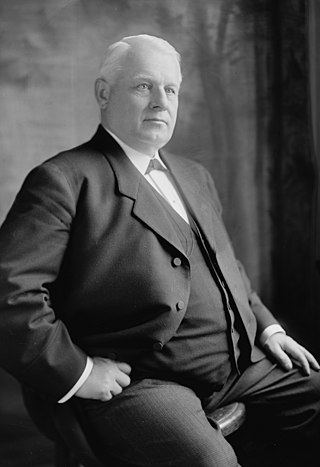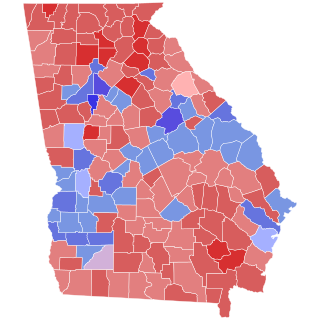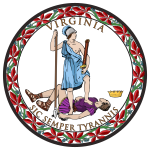
Carter Glass was an American newspaper publisher and Democratic politician from Lynchburg, Virginia. He represented Virginia in both houses of Congress and served as the United States Secretary of the Treasury under President Woodrow Wilson. He played a major role in the establishment of the U.S. financial regulatory system, helping to establish the Federal Reserve System and the Federal Deposit Insurance Corporation.

Since Idaho became a U.S. state in 1890, it has sent congressional delegations to the United States Senate and United States House of Representatives, beginning with the 51st United States Congress. Prior to 1890, Idaho sent non-voting delegates to the House of Representatives from 1864 to 1889. Each state elects two senators to serve for six years in general elections, with their re-election staggered. Prior to the ratification of the Seventeenth Amendment in 1913, senators were elected by the Idaho Legislature. Each state elects a varying number of, but at least one, member of the House, depending on population, to two-year terms. Idaho has sent two members to the House in each congressional delegation since the 1910 United States Census.

The 1946 United States Senate elections were held November 5, 1946, in the middle of Democratic President Harry S. Truman's first term after Roosevelt's passing. The 32 seats of Class 1 were contested in regular elections, and four special elections were held to fill vacancies. The Republicans took control of the Senate by picking up twelve seats, mostly from the Democrats. This was the first time since 1932 that the Republicans had held the Senate, recovering from a low of 16 seats following the 1936 Senate elections.

The 1972 United States House of Representatives elections were held on November 7, 1972, to elect U.S. Representatives to serve in the 93rd United States Congress. This was the first election held after the 1970 United States redistricting cycle. It coincided with the landslide reelection victory of President Richard M. Nixon. Nixon's Republican Party managed to gain a net of twelve House of Representatives seats from the Democratic Party, although the Democrats retained a majority.

Thomas Staples Martin was an American lawyer and Democratic Party politician from Albemarle County, Virginia, who founded a political organization that held power in Virginia for decades and who personally became a U.S. Senator who served for nearly a quarter century and rose to become the Majority Leader before dying in office.

The 1912–13 United States Senate elections were held on various dates in various states. They were the last U.S. Senate elections before the ratification of the Seventeenth Amendment in 1913, establishing direct elections for all Senate seats. Senators had been primarily chosen by state legislatures. Senators were elected over a wide range of time throughout 1912 and 1913, and a seat may have been filled months late or remained vacant due to legislative deadlock. Some states elected their senators directly even before passage of Seventeenth Amendment. Oregon pioneered direct election and experimented with different measures over several years until it succeeded in 1907. Soon after, Nebraska followed suit and laid the foundation for other states to adopt measures reflecting the people's will. By 1912, as many as 29 states elected senators either as nominees of their party's primary or in conjunction with a general election.

The 2008 United States Senate election in Georgia took place on November 4, 2008. The runoff election took place on December 2, 2008. Republican Senator Saxby Chambliss, first elected in 2002, sought re-election to his position as a United States Senator from Georgia. He was challenged by Democratic nominee Jim Martin and Libertarian nominee Allen Buckley. After a runoff election on December 2, Chambliss was elected.

The 1920 New York state election was held on November 2, 1920, to elect the governor, the lieutenant governor, the secretary state, the state comptroller, the attorney general, the state treasurer, the state engineer, two judges of the New York Court of Appeals and a U.S. Senator, as well as all members of the New York State Assembly and the New York State Senate.

The 1920 South Carolina United States Senate election was held on November 2, 1920 to select the U.S. Senator from the state of South Carolina. Incumbent Democratic Senator Ellison D. Smith won the Democratic primary and was unopposed in the general election to win another six-year term.

The 1827 United States Senate election in New York was held on February 6, 1827, by the New York State Legislature to elect a U.S. Senator to represent the State of New York in the United States Senate.

The 1922 United States Senate special election in Pennsylvania was held on November 7, 1922. Incumbent Republican Senator George Pepper, who had been appointed to the seat by Governor William Sproul following the death of Boies Penrose, was elected to fill the remaining four years on the term to which Penrose had been elected in 1920. Pepper comfortably defeated five other candidates, including Democratic nominee Fred Kerr of Clearfield County.

The 1920 United States Senate election in Arizona took place on November 2, 1920. Incumbent Democratic U.S. Senator Marcus A. Smith ran for reelection to a third term, but was defeated by former Delegate to the U.S. House of Representatives from the Arizona Territory Ralph H. Cameron in the general election. Cameron would become the first Republican elected to the office of U.S. Senator from Arizona since the state joined the union in 1912. The same year, Republican Governor Thomas Edward Campbell was reelected to a second term.

The 1920 United States Senate election in Connecticut was held on November 2, 1920.

The 1920 United States Senate election in Washington was held on November 2, 1920. Incumbent Republican U.S. Senator Wesley Livsey Jones was re-elected to a third term in office over Farmer-Labor nominee Clemens J. France and former Seattle mayor George F. Cotterill.

The 1922 United States Senate election in Virginia was held on November 7, 1922. Incumbent Senator Claude A. Swanson was re-elected to a third term after defeating Republican J. W. McGavock. Swanson and fellow Senator Carter Glass were the first U.S. Senators to be elected by popular vote following the passage of the Seventeenth Amendment.

The 1946 United States Senate special election in Virginia was held on November 5, 1946. Appointed Democratic Senator Thomas G. Burch retired after filling the vacancy caused by the death of Senator Carter Glass. Absalom Willis Robertson defeated Republican Robert H. Woods and was elected to finish Glass's term in office.

The 2016 United States House of Representatives elections were held on November 8, 2016, to elect representatives for all 435 congressional districts across each of the 50 U.S. states to the 115th United States Congress. Non-voting members for the District of Columbia and territories of the United States were also elected. These elections coincided with the election of President Donald Trump, although his party lost seats in both chambers of Congress. The winners of this election served in the 115th Congress, with seats apportioned among the states based on the 2010 United States census. In October 2015, the House elected a new Speaker, Republican Paul Ryan, who was re-elected in the new term. Democrat Nancy Pelosi continued to lead her party as Minority Leader. Elections were also held on the same day for the U.S. Senate, many governors, and other state and local elections.

From March 9 to June 5, 1920, voters of the Democratic Party elected delegates to the 1920 Democratic National Convention, for the purposing of choosing a nominee for president in the 1920 United States presidential election.

The 1930 United States Senate election in Texas was held on November 4, 1930. Incumbent Democratic U.S. Senator Morris Sheppard was re-elected to a fourth term in office, easily dispatching his challengers.

The 1920 United States presidential election in Ohio was held on November 2, 1920, as part of the 1920 United States presidential election. State voters chose 24 electors to the Electoral College, who voted for president and vice president.




















